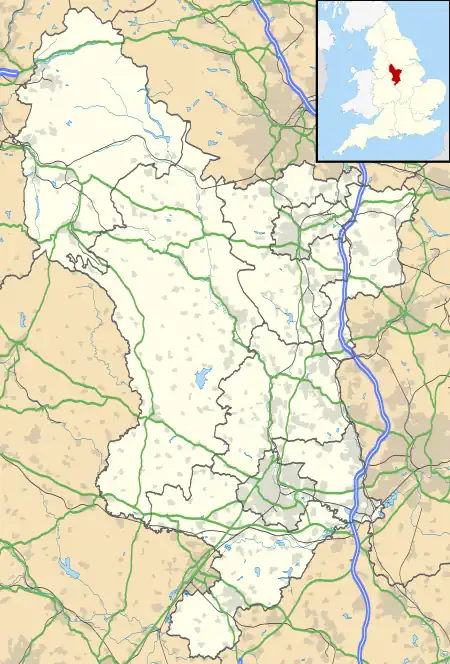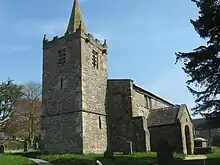Kniveton
Kniveton is a village and civil parish in Derbyshire, England. It is in the Peak District, 3 miles (4.8 km) north east of Ashbourne, 6 miles (9.7 km) south west of Wirksworth and 150 miles (240 km) from London. It is close to the reservoir at Carsington Water.
| Kniveton | |
|---|---|
.jpg.webp) | |
 Kniveton Location within Derbyshire | |
| OS grid reference | SK207501 |
| District | |
| Shire county | |
| Region | |
| Country | England |
| Sovereign state | United Kingdom |
| Post town | ASHBOURNE |
| Postcode district | DE6 |
| Police | Derbyshire |
| Fire | Derbyshire |
| Ambulance | East Midlands |
| UK Parliament | |
History
Toponymy
The name Kniveton derives from Cengifu and tun, meaning the farmstead of a woman named Cengifu, an Old English personal name.[1]
Early history
There are two scheduled barrows in Kniveton; Thomas Bateman excavated one in 1845. A later excavation revealed a riveted bronze dagger with an ivory pommel, an urn or food vessel, a perforated stone axe and an amber ring.[2]
Kniveton is mentioned in Domesday, where it is recorded as Cheniveton. The manor belonged to the Kniveton family. The manor was sold after 1660 to the Lowe family and afterwards to the Pegge family who sold it to the Meynells.[3]
During the 19th century the inhabitants worked in the cotton mills. Lime-burning and agriculture were other occupations.[4]
Governance
Historically Kniveton was a township, parish and village in the Western division of the county, part of the ancient Wirksworth hundred, and part of the Ashbourne Poor Law Union which came into existence in January 1845.[5][6] The coat of arms on display in the church's stained glass window is that of the Kniveton family.
Geography
Kniveton covers 1,974 acres (7.99 km2). The underlying rock is limestone and the soil is heavy, much of it pastureland.[5]
Radio navigation beacon
Kniveton also has a VOR/DME Beacon used for air traffic control to the north of the village centre.
Demography
Population change
| Population growth in Kniveton from 1881–1961 | |||||||||||
|---|---|---|---|---|---|---|---|---|---|---|---|
| Year | 1881 | 1891 | 1901 | 1911 | 1921 | 1931 | 1951 | 1961 | |||
| Population | 272 | 269 | 266 | 268 | 260 | 253 | 265 | 276 | |||
|
Kniveton Ch/CP/AP[7] | |||||||||||
Education
In 1715 John Hurd gave land for the endowment of a school at Kniveton.[4] A church school was built in 1861.[5] Today Kniveton CE Primary School serves the village and the surrounding rural community.[8]
Religion

The church in Kniveton was originally a chapelry to St Oswald's church in Ashbourne.[5] St Michael and All Angels' Church has Norman origins as evidenced in the plain semi-circular arch of the porch. It is on a small hill and built of coursed rubble gritstone with ashlar dressings in the Early English style. It dates from the 13th century and consists of chancel, nave, south porch and a low embattled western tower with a short spire. The tower has two 17th-century bells, one dated 1665.[5][9][10] St Michael's Church is a Grade I listed building.[11]
The former Kniveton Methodist Church dates from 1832. It is built of red brick on a stone plinth with a tiled roof. It is a Grade II listed building.[12][13]
See also
References
Notes
- Mills 1998, p. 210
- Kniveton, megalithic.co.uk, retrieved 12 December 2009
- Lysons, Daniel & Samuel (1817), Magna Britannia Vol 5 Topographical and Historical Account of Derbyshire, British History Online, pp. 192_202, retrieved 12 December 2009
- Kniveton, genuki.org.uk/, retrieved 12 December 2009
- Kniveton Kelly, andrewspages, archived from the original on 4 May 2010, retrieved 12 December 2009
- PėLU, workhouses.org.uk, archived from the original on 5 June 2011, retrieved 12 December 2009
- Kniveton Ch/CP/AP Population Change, visionofbritain.org.uk, retrieved 12 December 2009
- School, derbyshire.sch.uk, archived from the original on 25 August 2010, retrieved 12 December 2009
- Kniveton gallery, wishful-thinking.org.uk, archived from the original on 30 October 2007, retrieved 12 December 2009
- Church, derbyshireuk.net, retrieved 12 December 2009
- Historic England, "St Michael (1146435)", National Heritage List for England, retrieved 12 December 2009
- Historic England, "Former Chapel (1311858)", National Heritage List for England, retrieved 12 December 2009
- Historic England. "Former Wesleyan Chapel (Grade II) (1311858)". National Heritage List for England. Retrieved 19 January 2019.
Bibliography
- Mills, A. D. (1998), Dictionary of English Place-Names, Oxford, ISBN 0-19-280074-4 (subscription required)
External links
![]() Media related to Kniveton at Wikimedia Commons
Media related to Kniveton at Wikimedia Commons